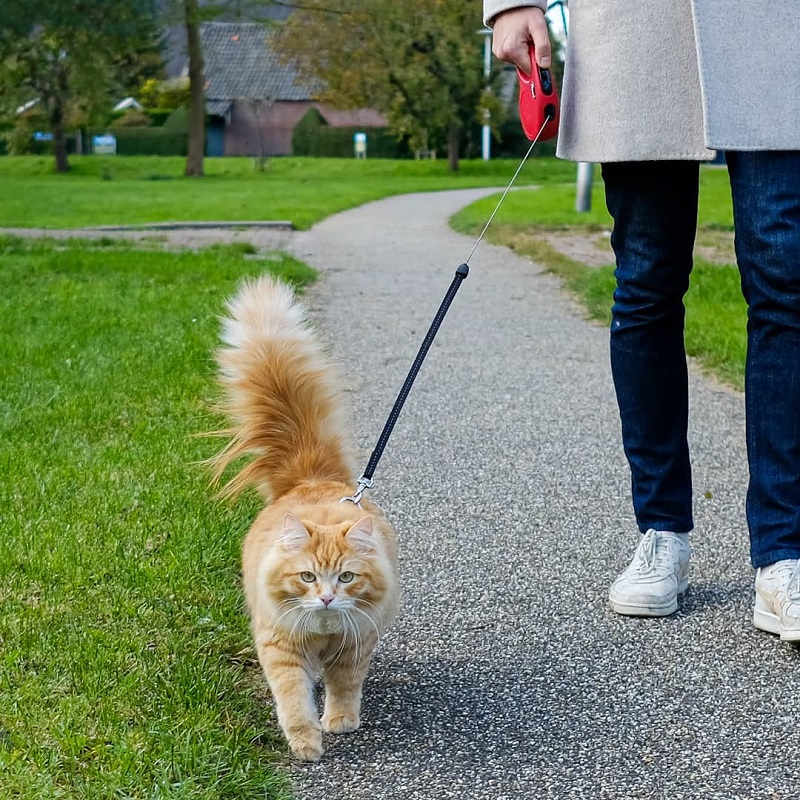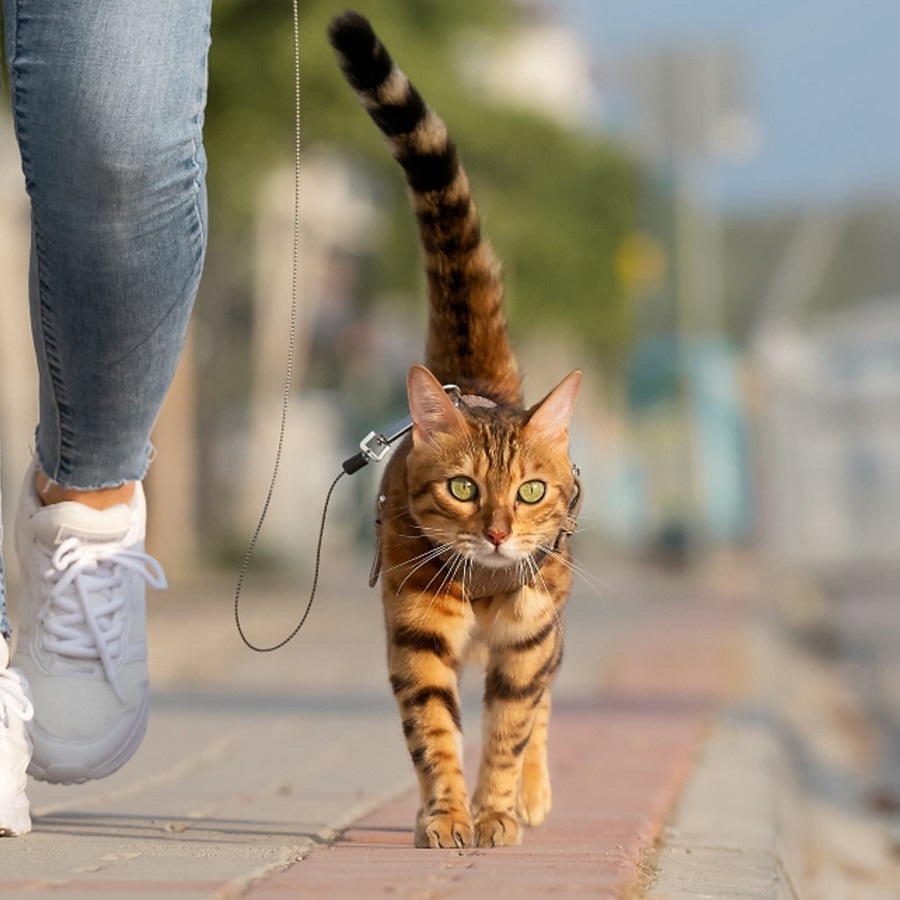Exploring the great outdoors is a delightful experience for many pets, and while dogs are commonly seen on leashes, the idea of walking a cat might seem unusual. However, with proper training and the right approach, many cats can enjoy safe outdoor adventures on a leash. This article delves into whether cats like leashes, the benefits and challenges of leash training, and essential tips for a successful outdoor exploration.
Understanding the Basics of Leash Training for Cats
Why Consider Leash Training for Your Cat?
Leash training for cats can provide numerous benefits. For one, it allows indoor cats to experience the sights, sounds, and smells of the outside world in a controlled and safe manner. This exposure can be mentally stimulating and help alleviate boredom and behavioral issues. Additionally, leash training can be particularly beneficial for cats who are otherwise reluctant to go outside or have a history of escaping. By introducing outdoor exploration gradually and safely, leash training can enhance your cat’s quality of life and provide enrichment opportunities that stimulate their natural instincts.
How to Choose the Right Leash and Harness
Selecting the appropriate leash and harness is crucial for successful leash training. Opt for a harness designed specifically for cats, as these are usually more secure and comfortable than those made for dogs. A good cat harness should fit snugly but not restrict movement. It should also be adjustable to accommodate your cat’s growth and changes in body size. For the leash, a lightweight, non-retractable leash is often best, as retractable leashes can be cumbersome and less controllable. Ensure that the harness is made of breathable material to keep your cat comfortable during outdoor adventures.

The Initial Steps of Introducing a Leash to Your Cat
Gradual Introduction to the Harness
Introducing a harness to your cat should be a gradual process to ensure they feel comfortable and not stressed. Start by letting your cat sniff and explore the harness while it’s off. Once they seem accustomed to its presence, gently place the harness on them for short periods, gradually increasing the duration. Offer treats and praise to create a positive association with the harness. Avoid forcing the harness onto your cat, as this can create negative associations and hinder the training process. Patience and positive reinforcement are key to helping your cat become comfortable with the harness.
Getting Used to the Leash
Once your cat is comfortable wearing the harness, you can introduce the Leash training. Attach the leash to the harness while indoors and allow your cat to drag it around, so they get used to the feeling of the leash. Supervise them closely to ensure they don’t become tangled or scared. Practice walking with the leash indoors before venturing outside. This helps your cat associate the leash with positive experiences and reduces the likelihood of them becoming anxious when you eventually transition to outdoor exploration.
Ensuring a Safe and Enjoyable Outdoor Experience
Choosing the Right Environment for Outdoor Exploration
When you first start taking your cat outside, choose a safe, enclosed environment where they can explore without the risk of running away or encountering dangerous situations. A quiet garden or a secure, fenced yard is ideal. Avoid busy streets, other animals, and areas with potential hazards. Gradually increase the complexity of the environment as your cat becomes more comfortable and confident. Always be vigilant and ready to intervene if your cat seems frightened or stressed. A controlled, secure environment is essential for a positive and safe outdoor experience.
Monitoring Your Cat’s Behavior and Comfort
Pay close attention to your cat’s behavior and comfort level during outdoor excursions. Look for signs of stress or discomfort, such as hiding, excessive meowing, or trying to escape. If your cat appears anxious, return indoors and try shorter, more frequent outings to build their confidence. Ensure that your cat is well-hydrated and take breaks in shaded areas if it’s hot outside. It’s also important to keep a close eye on their paws and body for any signs of injury or irritation. Your cat’s safety and well-being should always be your top priority during outdoor adventures.

Common Challenges and How to Overcome Them
Dealing with a Cat’s Fear or Anxiety
Cats may react with fear or anxiety when exposed to new experiences, and outdoor environments can be overwhelming for them. If your cat shows signs of fear, such as hissing, growling, or attempting to hide, it’s important to remain calm and avoid forcing them to continue. Gradually desensitize your cat to the outdoor environment by starting with short, positive experiences and gradually increasing the duration. Use treats, toys, and praise to reward calm behavior and create positive associations with outdoor exploration. Patience and understanding are crucial for overcoming fear and building your cat’s confidence.
Handling Unexpected Situations and Distractions
Outdoor environments can present various distractions and unexpected situations, such as other animals, loud noises, or unfamiliar scents. Be prepared to handle these situations calmly and effectively. Keep a firm grip on the leash and use commands or distractions to redirect your cat’s attention if they become overly excited or scared. Ensure that your cat’s harness and leash are secure to prevent escapes in case they become startled. Regularly practice leash training in different environments to help your cat become accustomed to handling distractions and unexpected occurrences.
Benefits of Leash Training for Cats
Physical Exercise and Mental Stimulation
Leash training offers significant benefits for your cat’s physical and mental well-being. Outdoor exploration provides physical exercise, helping to keep your cat healthy and prevent obesity. The mental stimulation from exploring new environments also engages their natural instincts and curiosity, reducing boredom and associated behavioral issues. Regular outdoor activity can improve your cat’s overall health and happiness, making leash training a valuable addition to their routine. By providing a stimulating environment and physical activity, you contribute to your cat’s long-term well-being and enrichment.
Strengthening the Bond Between You and Your Cat
Leash training can also enhance the bond between you and your cat. Engaging in outdoor adventures together fosters trust and creates shared experiences that strengthen your relationship. The process of training and exploring together can build a deeper connection and improve communication between you and your cat. Positive interactions and shared experiences contribute to a stronger, more trusting bond. By spending quality time together and providing enjoyable experiences, you enhance your cat’s trust and affection towards you.
Alternatives to Leash Training for Outdoor Exploration
Catios and Enclosed Outdoor Spaces
If leash training is not suitable for your cat, consider alternatives such as catios or enclosed outdoor spaces. Catios are outdoor enclosures designed specifically for cats, providing a safe environment for them to enjoy the outdoors without the risk of escaping. These enclosed spaces can be customized to include climbing structures, toys, and other enrichment features. Catios offer a controlled environment where your cat can experience the outdoors safely and comfortably. If a catio is not feasible, look for other secure outdoor spaces that allow your cat to enjoy fresh air and stimulation while remaining safe.
Interactive Indoor Play and Enrichment
For cats who are not interested in leash training or outdoor exploration, interactive indoor play and enrichment can provide similar benefits. Toys, puzzles, and climbing structures can simulate outdoor experiences and keep your cat engaged. Rotate toys regularly to maintain interest and provide opportunities for physical exercise and mental stimulation. Interactive play sessions with you can also enhance your bond and reduce boredom. By creating a stimulating indoor environment, you ensure your cat remains active and happy without needing to go outside.

Conclusion
Leash training can be a rewarding experience for both you and your cat, offering opportunities for safe outdoor exploration and enrichment. By understanding the basics of leash training, choosing the right equipment, and following essential safety tips, you can provide your cat with enjoyable and stimulating outdoor adventures. Patience and positive reinforcement are key to successful leash training, and by monitoring your cat’s behavior and comfort, you ensure a safe and enjoyable experience. If leash training is not suitable, alternatives such as catios and interactive indoor play can also offer valuable enrichment for your cat’s well-being. With the right approach, leash training can enhance your cat’s quality of life and strengthen your bond.










